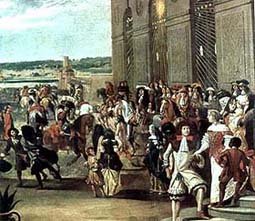Late baroque fashion

The late Baroque era, also termed the Goldern Age, lasted until the death of Louis XIV in 1715, as paralysed stylistically as the aged King was in his ways. The following era of the régence broke the spell and rang in the age of Rococo.
This era is known as a study in opulence. Fashion here was beginning to be driven primarily by the french court of Louis XIV and the English court of Charles I. The style of dress most associated with this period was known as "Cavalier" style.
Female fashion
Nearing 1660, panniers became wider, waistlines lowered and overskirts looped up on either side of the underdress. Sleeves often ended at the elbow and were trimmed with long lace cuffs or turned-up triangular cuffs. Pointed corsets reminiscent of the Elizabethan style came into fashion again. Around 1680, sleeves were puffed and sometimes segmented by ribbon ties, and overskirts looped up to form small trains at the back of floor-length skirts. Lace trim became more popular with the upper classes, and satins and silks replaced coarser materials. Panniers grew smaller again, and skirts became less full. Necklines were usually rounded and edged in lacy materials. At the turn of the century, skirts became layered or tiered, and decorative aprons became fashionable. Bodices were still corseted and pointed, and sleeves were fitted to the elbow and finished with lace.

Male fashion
After 1660, ruffles became quite common, and lace was everywhere on jackets and breeches alike. Necklines were high and decorated with lace ruffles at the neck. The more ornate style dress from 1660 to 1680 might be accounted for by the return of the monarchy to England. Near the end of that period, doublets were replaced by long coats not cinched at the waist and ending at the mid-thigh or just above the knee. Lace cuffs and fine pleating were still in style, however, and longer trousers were shortened to breeches that were tied above the knee. Between 1685 and 1690, men wore long coats with braided front panels adorned with buttons from neck to hem. Breeches were high--at or just above the knee--and fine hose was worn beneath. Necklines remained high and decorated with lace ruffles. This style remained virtually unchanged until 1715.
 Thanks to
Thanks toLibrary

0 Comments:
Post a Comment
<< Home